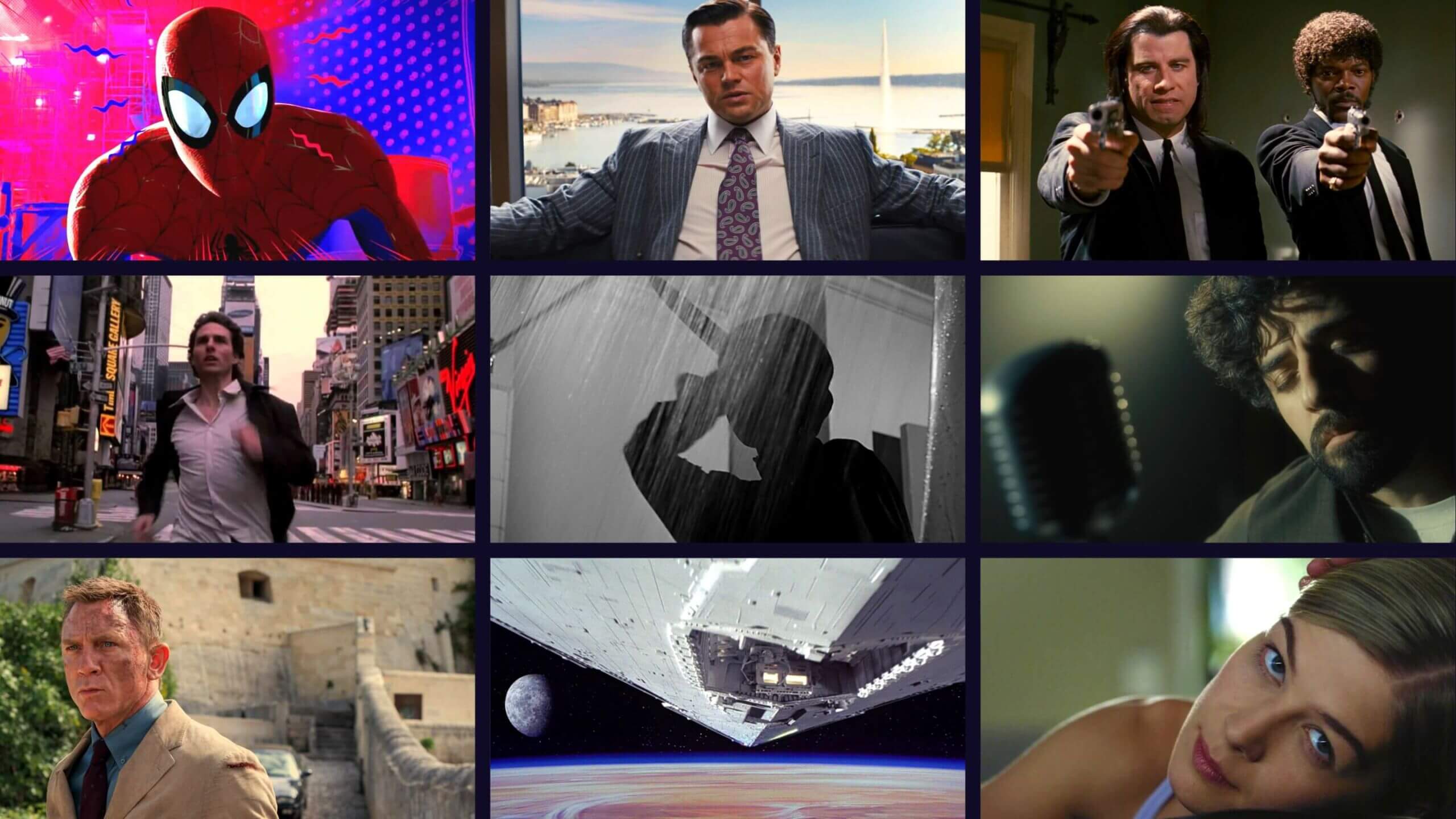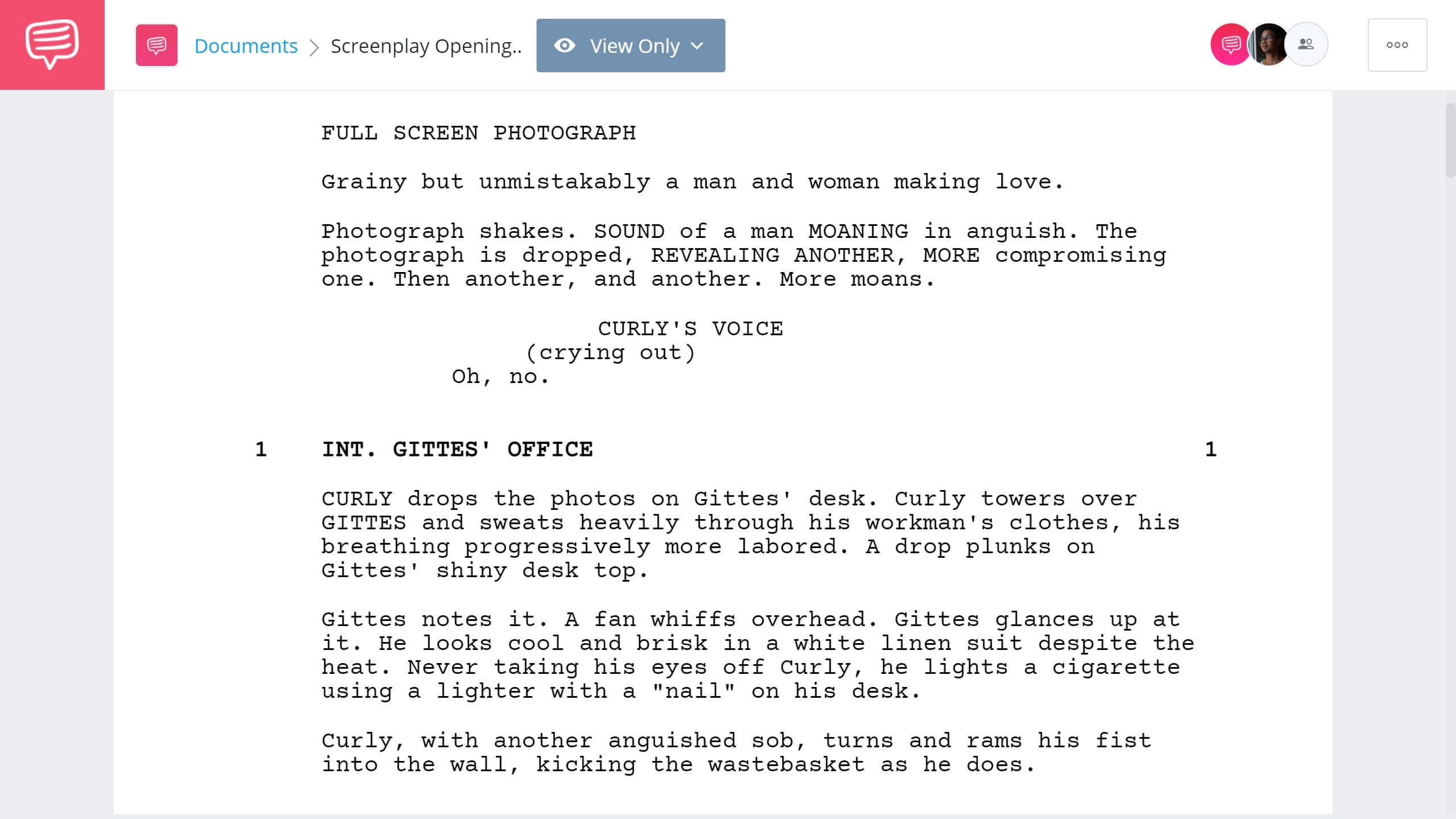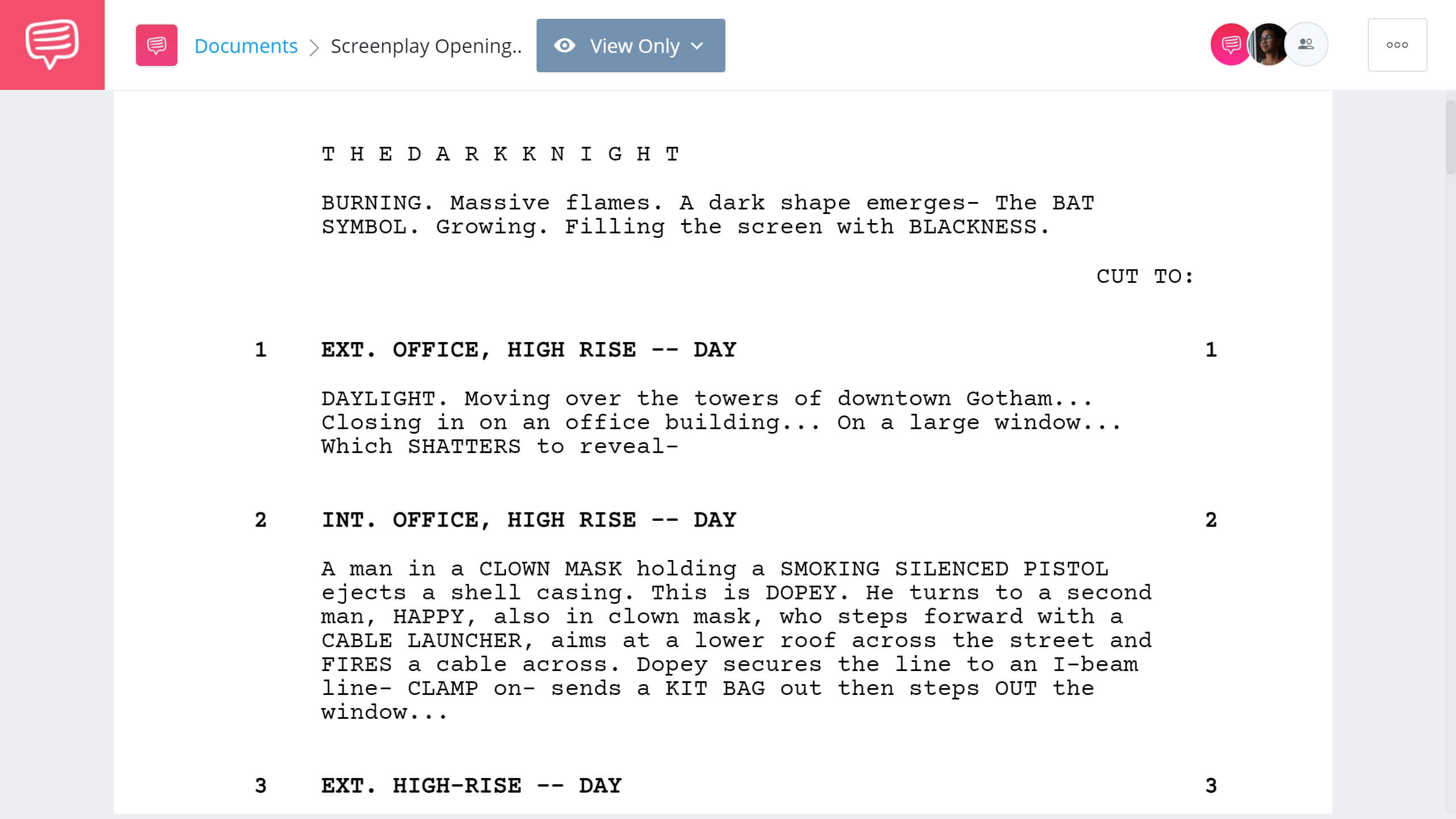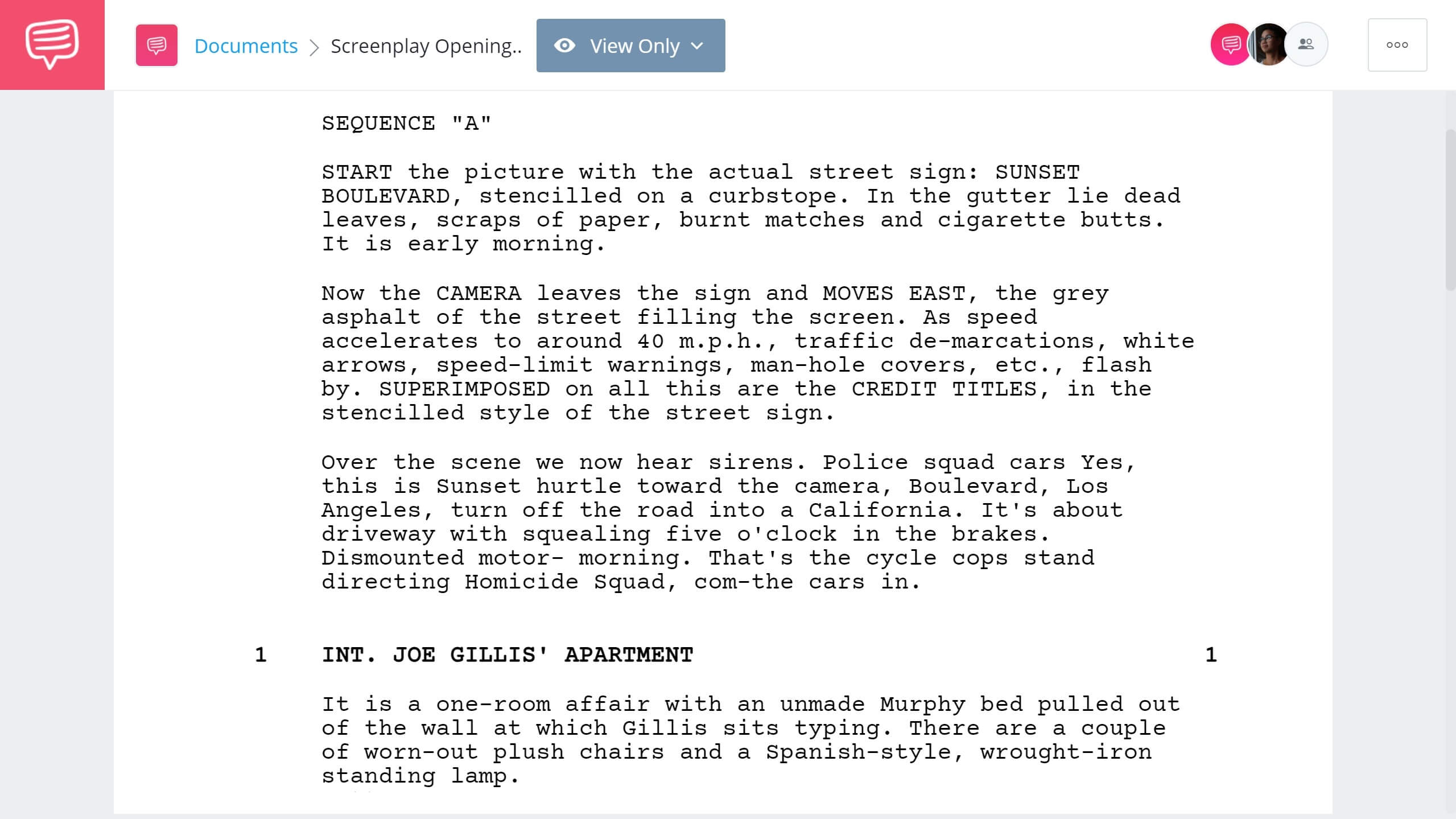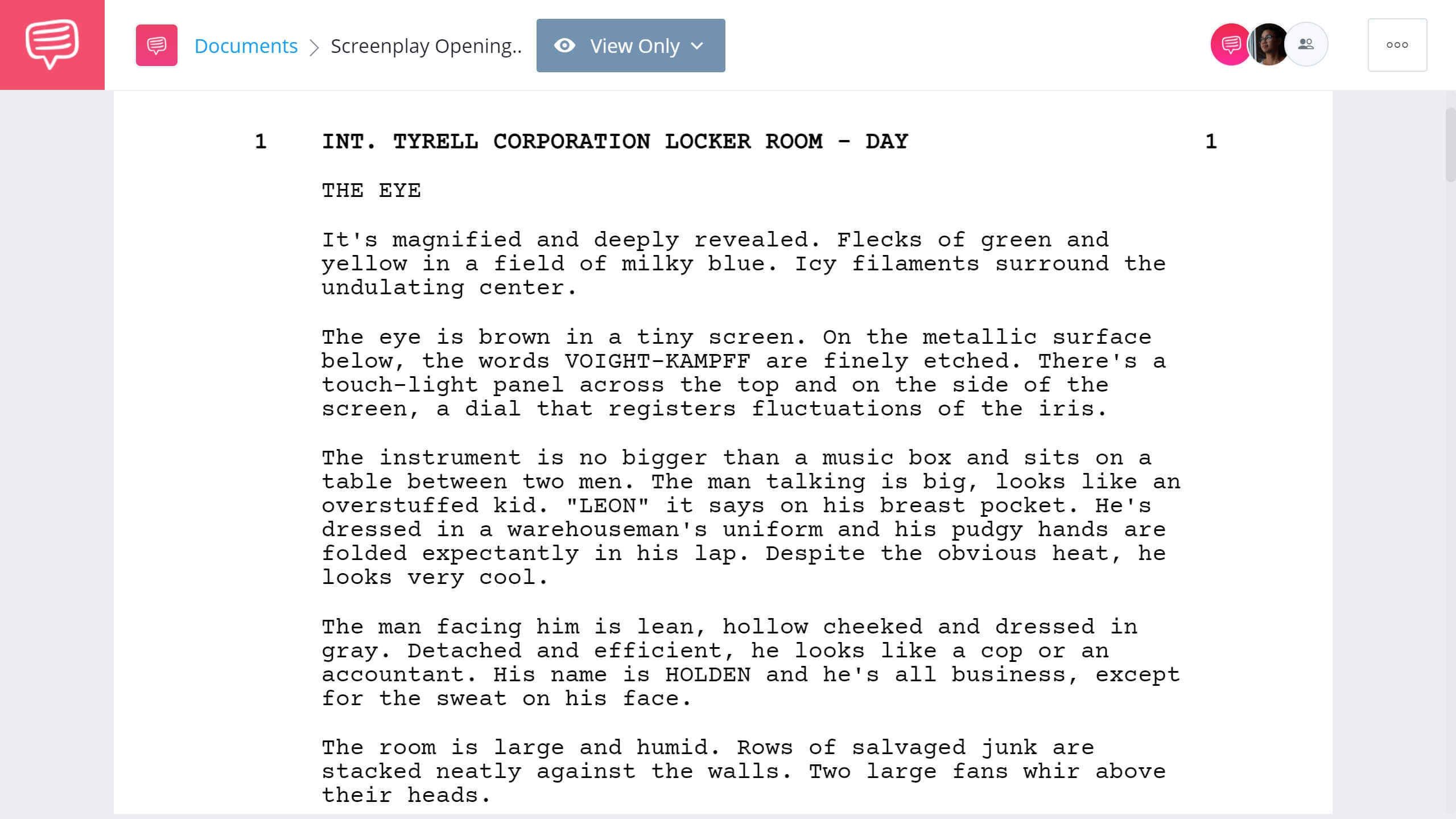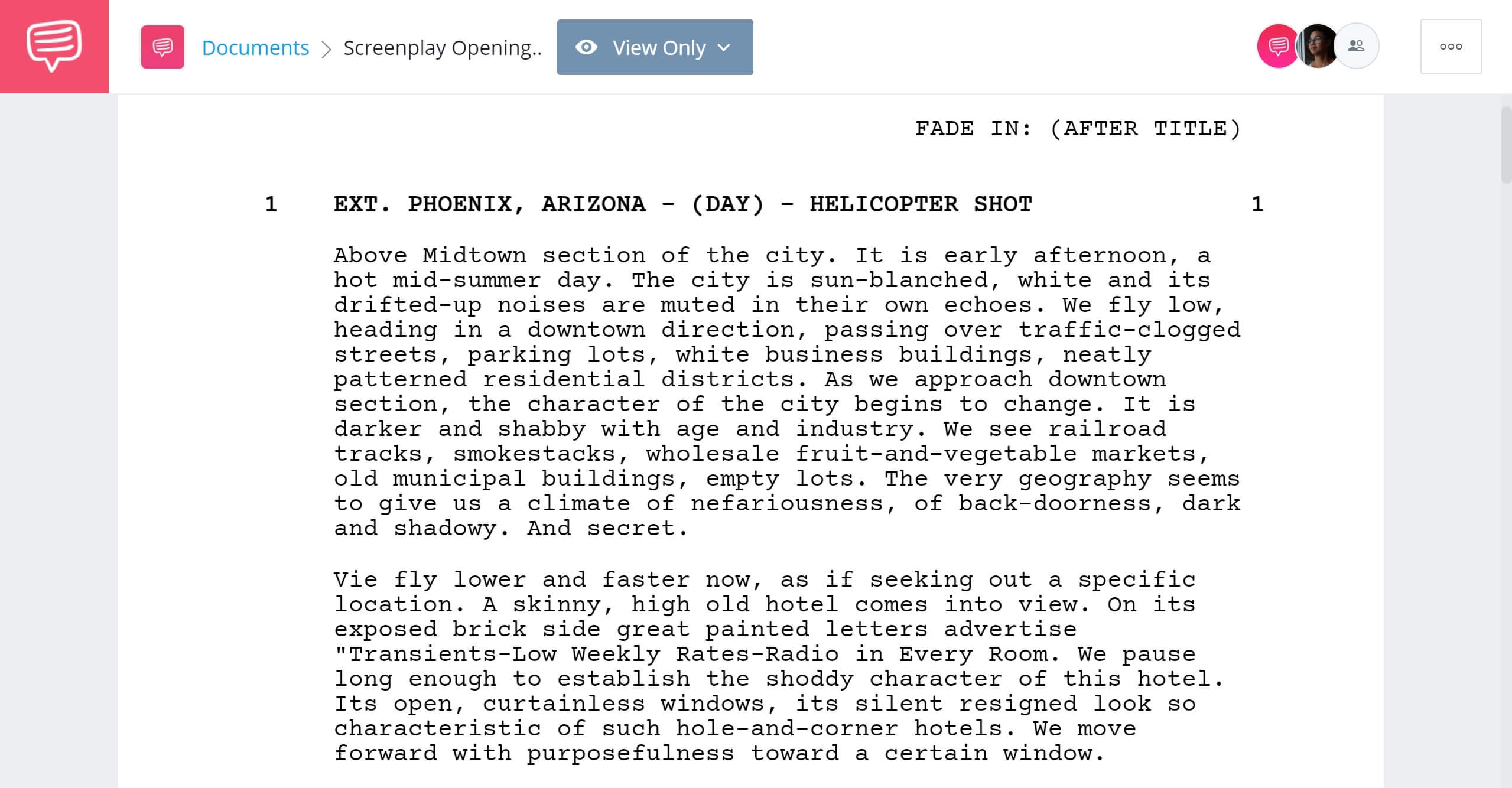Of all of the parts of a screenplay, the opening scene is perhaps the most important – not only because it has to establish the world of the story, but because it also has to grab the attention of the script-reader. We’re going to look at a few different ways you can start your screenplay with a bang, with opening scene script examples from Chinatown, Blade Runner, and more. By the end, you’ll be equipped with a variety of new strategies to tackle screenplay opening scenes like Robert Towne and Orson Welles.
Screenplay Opening Scene Examples
How to open a screenplay
A lot of people will tell you that “99% of scripts are rejected after the first scene.” And although there’s definitely some merit to that perspective, it’s not helpful to put that pressure on yourself as a screenwriter. The truth of the matter is that good stories get noticed, and good opening scenes are a big reason why.
Our video on the “Art of the Opening Scene” looks at how to write an opening scene for a movie, with a strong emphasis on script elements.
How to Begin a Movie 6 Ways • Subscribe on YouTube
Now that we’ve seen some of the foundational elements of establishing film elements in the opening scene of screenplays, let’s break down a few different strategies for how to implement them.
Film Script Examples
Start with the protagonist
How many times have you watched a movie’s opening scene and asked, “who’s the main character? Your protagonist doesn’t have to be in the opening scene, but it almost always works better when they are.
Why? There are three reasons:
- It gives the narrative focus
- To establish point of view
- And to build emotional resonance from the get-go
We imported the Chinatown screenplay into StudioBinder’s screenwriting software to take a look at how Robert Towne addressed all three of these points in the opening scene. As you’re reading, consider marking up the spots where Towne communicates narrative focus, POV and emotional resonance.
Screenplay Opening Scene Examples • Read Chinatown Opening Scene
From the very first page, we know that Jake Gittes is the protagonist of the story. Why? Because he’s clearly in a position of control. Gittes’ domineering presence gives the narrative focus and it puts us behind his point of view.
Towne also builds emotional resonance by making Gittes sympathetic and supportive to Curly. So, in just a few pages, we see a great amount of characterization. Ultimately, the opening scene of Chinatown succeeds due to how it establishes its characters.
Related Posts
Scene Script Examples
Start with the antagonist
There are times when starting your story with the antagonist may work better than starting it with the protagonist. Especially when we already know the protagonist, it doesn’t make sense to re-establish fundamental aspects of their character in the first scene. Instead, the opening scene is often better suited to focus on an antagonist.
Let’s look at the opening scene of Christopher Nolan’s The Dark Knight script to see how he enticed us with the story’s villain, the Joker.
Screenplay Opening Scene Examples • Read The Dark Knight Opening Scene
The opening scene of The Dark Knight does a great job of establishing the Joker’s character. In a greater sense, it does a great job of establishing the primary conflict of the story. We know by osmosis that the Joker and Batman are going to be the story’s villain and hero.
Since the movie is literally named after Batman, we don’t need to see anything more to know that he’s the primary focus. So, by choosing to show the Joker from the get-go, Nolan thrusts us right into the action. The end result is a conflict-driven plot foundation.
How to Begin a Movie
Start with the end
One of the boldest choices you can make in screenwriting is to start your screenplay at the linear end of the story, then flashback to the beginning. And when it’s done well, it can pay enormous dividends. I can’t think of any better example of this type of screenplay opening executed to perfection than Charles Brackett, Billy Wilder, and D.M. Marshman Jr.’s Sunset Boulevard.
As you’re reading the opening scene to Sunset Boulevard, think about how the writers make us care about the main character in just a few pages.
Film Script Examples • Read the Sunset Boulevard Opening Scene
The writers of Sunset Boulevard employ a narration strategy that we see in many of the best Twilight Zone episodes. The narrator gives a brief explanation of the story’s context, but its chief purpose is to draw us in with a mystery. It makes us ask questions like, what’s going on? Where are we? When are we? Why is this happening?
Starting the story at the end is a brilliant mechanic that almost always grabs the attention of the reader. But it’s a double-edged sword too – if the audience knows the fate of the main character, they may feel less inclined to pay attention to the events that precede it.
Perhaps no screenplay has done a better job of building an enticing mystery in its opening scene than Orson Welles and Herman J. Mankiewicz’s Citizen Kane. Check out the clip below to see how Welles used chiaroscuro lighting, props and set design to give the film an ambiguous visual lens that matched the ambiguity of the script’s opening events.
Scene Script Examples to Screen • Watch the Citizen Kane Opening Scene
This opening scene only has one word of dialogue — “rosebud” — but it’s enough to make us ask: what’s going on? Where are we? When are we? And why is this happening?
The metaphorical importance of “rosebud” connects to the central theme of the story and serves as a narrative through-line that connects plot events from beginning to end. When you’re planning the opening scene of your own screenplay, consider foreshadowing how we’ll come back to it at the end. This in and of itself creates a natural sense of mystery and narrative continuity.
Related Posts
Opening Scene Examples
Establish the world
Setting starts with the very first slugline of the script – where we’re told the location, the time of day and the year or era (if it’s applicable to the story). For most stories, it’s extremely important that we know when and where we are by the end of the first scene. Of course, there are exceptions to this rule – think Lost for example – but the vast majority of the time, it’s best if setting is communicated early on.
One script that does an excellent job of communicating setting in the opening scene is Hampton Fancher and David Peoples’ Blade Runner. Let’s look at how they build the dystopian setting of an otherworldly Los Angeles through scene descriptions and actions.
Screenplay Opening Scene Examples • Read the Blade Runner Opening Scene
More than anything, the Blade Runner script opening scene succeeds in how it laid the groundwork for the visual spectacle that would become the film’s opening. Now that we’ve seen how Fancher and Peoples did it in the script, let’s take a look at how it came together in Ridley Scott’s final cut.
Film Script Examples to Screen • Watch the Blade Runner Opening Scene
As you can see, it’s clear from the get-go that Blade Runner is a story that takes place outside our reality. When writing your own screenplay, think about how Fancher and Peoples established the world for Ridley Scott to build with filmmaking techniques. Sometimes, all it takes is the use of terms like “salvaged junk,” “touch-light panel,” and “LASER BURNS” to give us the impression of a language outside our normal vernacular.
Opening Scene Screenplay Examples
Plant a red herring
A red herring is defined as “a narrative element that’s planted by a writer for the purpose of misleading the reader.” Stories as old as time have used red herrings to trick the audience into believing something that wasn’t true. For more on red herrings, check out our video below!
Techniques to Mislead and Distract an Audience • Subscribe on YouTube
Alfred Hitchcock’s Psycho contains one of the great red herrings of all-time. Let’s go to the script to see how we’re led to believe the story is headed in one direction, then thrown for a loop when it goes in a different direction.
Screenplay Opening Scene Examples • Psycho Opening Scene
Imagine reading the Psycho screenplay without knowing anything about Norman Bates and the fruit cellar? This scene would read like the beginning of a romantic drama. Honestly, it reads more like a Tennessee Williams play than an Alfred Hitchcock movie. And that’s the point.
The red herring in the Psycho screenplay is the false pretense of assuming we’re reading the story of Marion Crane, when, in reality, we’re reading the story of a character we haven’t met yet: Norman Bates.
By starting with a red herring, screenwriter Joseph Stefano distracts us from the true plot, which further aids its eventual shock value.
Screenplay Opening Scene Examples & More
Montage and other techniques
Montages — although somewhat out of style nowadays — have historically been used to great effect; a point proven by many of the best Woody Allen movies. Woody Allen’s Manhattan in particular does a great job of building mood and communicating tone. Let's take a look at the opening scene.
Film Script Examples to Screen • Woody Allen’s Manhattan Opening
Would this scene have worked as well without the stunning cinematography of Gordon Willis? No, probably not – but that doesn’t mean the structure of the writing lacks merit! Quite the contrary, it succinctly shows how to effectively write a montage in an opening scene.
The methods we’ve gone over aren’t the only methods for writing a great opening scene. Here are some other resources you may want to look at!
Related Posts
UP NEXT
Best opening scenes of all time
The opening scene of a screenplay plays an enormous role in how a film is set-up, and there’s perhaps no visual element that’s more important to the opening scene than the opening shot. In this next article, we look at the best opening scenes of all time. By the end, you’ll be ready to apply immersive filmmaking techniques, just like great cinematic directors.
